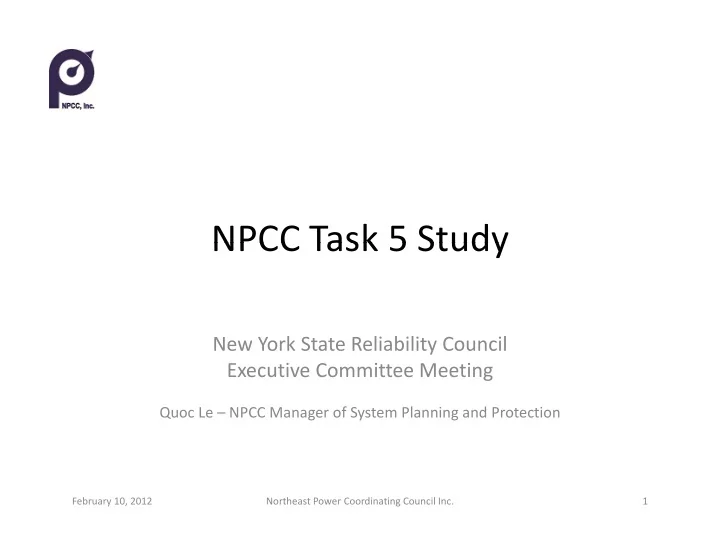

NPCC Task 5 Study NPCC Task 5 Study New York State Reliability Council Executive Committee Meeting Quoc Le – NPCC Manager of System Planning and Protection February 10, 2012 Northeast Power Coordinating Council Inc. 1
Presentation Outline Presentation Outline • Background Background • Study Objectives • Methodology h d l • Summary of Results • Conclusions • Recommendations Recommendations February 10, 2012 NPCC ‐ Quoc Le 2
Background Background • The Blackout Study included six separate tasks The Blackout Study included six separate tasks • Final report (Task 6) issued following the completion of Tasks 1 ‐ 4 – Report approved Nov. 2005 • Task 5 is the remaining Blackout Study task to be Task 5 is the remaining Blackout Study task to be completed • Task 5 delayed due to prioritization of work (e.g. y p ( g UFLS, OTA, etc.) February 10, 2012 NPCC ‐ Quoc Le 3
Objectives Objectives • Investigate potential mitigation measures to Investigate potential mitigation measures to improve ability of system to withstand a major system disturbance system disturbance • Review NERC technical reference on Power Plant and Transmission System Protection Plant and Transmission System Protection Coordination and recommend protection functions that could benefit from including functions that could benefit from including explicit or screening models in studies February 10, 2012 NPCC ‐ Quoc Le 4
Methodology Methodology • Develop study cases Develop study cases • Assess coherent generation groups • Investigate potential advance indicators of • Investigate potential advance indicators of system separation • Assess performance of post contingency • Assess performance of post contingency actions • Assess benefits of tripping where out ‐ of ‐ step • Assess benefits of tripping where out ‐ of ‐ step conditions occur February 10, 2012 NPCC ‐ Quoc Le 5
Results of Coherent Generation Groups Analysis l • Two coherent generation groups (N ‐ S ‐ C ‐ E and Two coherent generation groups (N S C E and NE ‐ S ‐ C ‐ E) identified for Ontario • One coherent generation group identified for • One coherent generation group identified for the Maritimes consistent with prior study • Two coherent generation groups (New T h i (N England ‐ Maritimes and Northern Maine ‐ Maritimes) identified for New England M i i ) id ifi d f N E l d • One coherent generation group identified as West of Central East for New York February 10, 2012 NPCC ‐ Quoc Le 6
Evaluation of Potential Advance Indicators of System Separation d f • Change in power flow supervised by change in bus g p p y g voltage angle • Triggers using Phasor Measurement Unit data – Bus voltage angle difference – Bus frequency difference and its derivative – Bus voltage magnitude and its derivative Bus voltage magnitude and its derivative • Bus voltage angular velocity vs. bus voltage angular acceleration • Generator rotor speed/frequency and acceleration • Reactive power and its derivative (Q ‐ Qdot) February 10, 2012 NPCC ‐ Quoc Le 7
Performance of post contingency actions • Bus frequency responses demonstrated Bus frequency responses demonstrated controlled system separation/islanding along boundaries that minimize generation load boundaries that minimize generation load mismatch is preferable to uncontrolled separation separation • Out ‐ of ‐ step generation rejection demonstrated potential for preventing demonstrated potential for preventing uncontrolled system separation February 10, 2012 NPCC ‐ Quoc Le 8
Results on Tripping where OOS conditions occur d • The system would still have separated as it did The system would still have separated as it did on August 14, 2003 even if the two 120 kV cables connecting Southern and Northern cables connecting Southern and Northern Detroit were tripped • System separation at locations where out of • System separation at locations where out ‐ of ‐ step conditions occur helps reduce voltage and power oscillations and power oscillations February 10, 2012 NPCC ‐ Quoc Le 9
Conclusions Conclusions • It is beneficial to separate the system where out ‐ It is beneficial to separate the system where out of ‐ step conditions occur • Controlled system separation is preferred in the Controlled system separation is preferred in the presence of a single coherent generation group • A reliable advance indicator for system separation • A reliable advance indicator for system separation could not be determined from this study • Uncoordinated generation protection schemes • Uncoordinated generation protection schemes should be modeled in planning and system studies studies February 10, 2012 NPCC ‐ Quoc Le 10
Recommendations Recommendations • Further studies are needed to determine the Further studies are needed to determine the reliability of the advance indicators for system separation p ‐ Need to be specific to particular locations, regional boundaries, or interfaces • Types of study identified which would benefit from including explicit or screening models for generator protection functions f February 10, 2012 NPCC ‐ Quoc Le 11
Generator Protection Functions to be Study Type Modelled via explicit Models via Screening Models UFLS Assessment Over/under-frequency V/Hz (24), under- (81), OOS (78) voltage (27), over- voltage (59) UVLS Study Under-voltage (27), over-current (51V) over-voltage (59) lt (59) Analysis of Large Over/under-frequency V/Hz (24), over-current System Disturbance (81), under-voltage (51V) (eg Event (eg. Event (27) over-voltage (59) (27), over-voltage (59), reconstruction of large OOS (78) scale blackout/system breakup) b ea up) Overall Transmission Over -frequency (81), under-voltage (27), Assessments OOS (78) over-voltage (59) Inter-regional Over-frequency (81), under-voltage (27), Transmission Studies OOS (78) over-voltage (59) February 10, 2012 NPCC ‐ Quoc Le 12
Recommend
More recommend